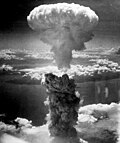Nuclear fission
| Advanced search |
- About 6 results found and you can help!
In nuclear physics and nuclear chemistry, nuclear fission is either a nuclear reaction or a radioactive decay process in which the nucleus of an atom splits into smaller parts (lighter nuclei), often producing free neutrons and photons (in the form of gamma rays), and releasing a very large amount of energy, even by the energetic standards of radioactive decay. The two nuclei produced are most often of comparable but slightly different sizes, typically with a mass ratio of products of about 3 to 2, for common fissile isotopes. Most fissions are binary fissions (producing two charged fragments), but occasionally (2 to 4 times per 1000 events), three positively charged fragments are produced, in a ternary fission. The smallest of these fragments in ternary processes ranges in size from a proton to an argon nucleus.
- See also: Wikipedia
- Related: Photofission, Cold fission, Nuclear Fusion
| The Effects of Nuclear Weapons The Effects of Nuclear Weapons www.atomicarchive.com/Effects/index.shtml - Web |
| Annotated bibliography for nuclear fission from th... Annotated bibliography for nuclear fission from the Alsos Digital Library alsos.wlu.edu/qsearch.aspx?browse=science/Fission - Web |
| The Discovery of Nuclear Fission The Discovery of Nuclear Fission www.aip.org/history/mod/fission/fission1/01.html - Web |
Gallery for «Nuclear fission»
Average relevance
| atomicarchive.com atomicarchive.com www.atomicarchive.com/Fission/Fission1.shtml - Web |
| Nuclear Files.org Nuclear Files.org www.nuclearfiles.org/.../what-is-fission.htm - Web |
| Nuclear Fission Animation Nuclear Fission Animation www.atomicarchive.com/Movies/Movie4.shtml - Web |



